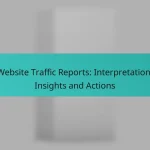What are the key email marketing best practices in the UK?
Key email marketing best practices in the UK focus on enhancing engagement and compliance with regulations. Effective strategies include personalization, segmentation, mobile optimization, clear calls-to-action, and consistent branding.
Personalization techniques
Personalization techniques involve tailoring email content to individual recipients based on their preferences and behaviors. This can include using the recipient’s name, recommending products based on past purchases, or sending targeted offers. Such strategies can significantly increase open and click-through rates.
To implement personalization, consider using data from customer interactions and surveys. Tools like dynamic content can help automate this process, ensuring each email feels unique to the recipient.
Segmentation strategies
Segmentation strategies involve dividing your email list into smaller groups based on specific criteria, such as demographics, purchase history, or engagement levels. This allows for more targeted messaging, which can lead to higher conversion rates.
Common segmentation methods include geographic location, buying behavior, and customer lifecycle stages. Regularly updating your segments based on new data will help maintain relevance and improve campaign performance.
Mobile optimization
Mobile optimization is crucial as a significant portion of emails are opened on mobile devices. Ensuring that your emails are responsive and easy to read on smaller screens can enhance user experience and engagement.
Use a single-column layout, larger fonts, and clear buttons for calls-to-action. Testing your emails on various devices before sending can help identify any issues that may hinder mobile usability.
Clear call-to-action
A clear call-to-action (CTA) guides recipients on what to do next, whether it’s making a purchase, signing up for a webinar, or downloading a resource. Effective CTAs are concise, visually distinct, and placed prominently within the email.
Consider using action-oriented language and contrasting colors to make your CTAs stand out. A/B testing different CTAs can provide insights into what resonates best with your audience.
Consistent branding
Consistent branding across your email campaigns helps build recognition and trust with your audience. This includes using the same logo, color scheme, and tone of voice in all communications.
Ensure that your emails reflect your brand identity and values. This consistency not only reinforces brand awareness but also enhances the overall professionalism of your communications.
How can I improve email open rates?
Improving email open rates involves crafting engaging subject lines and timing your sends effectively. By focusing on these elements, you can significantly boost the likelihood that recipients will open your emails.
Compelling subject lines
Compelling subject lines are crucial for capturing attention in crowded inboxes. Aim for clarity and intrigue, using action-oriented language that encourages recipients to open the email. For example, instead of “Newsletter Issue #5,” try “Unlock Exclusive Tips in This Week’s Newsletter!”
Keep subject lines concise, ideally under 50 characters, to ensure they display well on mobile devices. Avoid using all caps or excessive punctuation, as these can trigger spam filters. A/B testing different subject lines can help identify what resonates best with your audience.
Optimal send times
Optimal send times can vary based on your audience’s habits and time zones. Generally, mid-week days like Tuesday to Thursday tend to yield higher open rates, particularly in the late morning or early afternoon. Experiment with different times to find what works best for your specific audience.
Consider segmenting your email list by time zone to ensure that emails arrive at convenient times for all recipients. Additionally, monitor engagement metrics to adjust your sending schedule based on when your audience is most active.
What metrics should I track for email marketing success?
To measure email marketing success, focus on key metrics such as open rates, click-through rates, and conversion rates. These indicators provide insights into how well your campaigns are performing and where improvements can be made.
Open rates
Open rates indicate the percentage of recipients who opened your email. A typical open rate can range from 15% to 25%, depending on your industry and audience. To improve open rates, consider crafting compelling subject lines and optimizing send times.
Monitoring open rates helps you gauge the effectiveness of your subject lines and overall engagement. If your rates are low, it may be time to refine your targeting or re-evaluate your content strategy.
Click-through rates
Click-through rates (CTR) measure the percentage of recipients who clicked on one or more links within your email. A good CTR generally falls between 2% and 5%, but this can vary based on the type of email and the audience. Enhancing your call-to-action (CTA) can significantly boost these rates.
To optimize click-through rates, ensure your links are clear and enticing. A/B testing different CTAs and analyzing which ones resonate with your audience can lead to better engagement and higher CTRs.
Conversion rates
Conversion rates reflect the percentage of recipients who completed a desired action, such as making a purchase or signing up for a newsletter, after clicking through your email. This metric is crucial as it directly impacts your return on investment (ROI). Typical conversion rates can range from 1% to 5%, depending on the offer and audience.
To enhance conversion rates, focus on delivering relevant content and a seamless user experience. Clear landing pages and personalized follow-ups can help turn clicks into conversions, ensuring your email marketing efforts yield tangible results.
What are the legal requirements for email marketing in the UK?
Email marketing in the UK must comply with specific legal requirements, primarily governed by the General Data Protection Regulation (GDPR) and the Privacy and Electronic Communications Regulations (PECR). These regulations ensure that businesses obtain consent from recipients before sending marketing emails and provide clear guidelines on data protection and privacy.
GDPR compliance
GDPR compliance is crucial for email marketing in the UK. Businesses must obtain explicit consent from individuals before sending marketing communications. This means that recipients should clearly understand what they are consenting to and have the option to withdraw their consent at any time.
To ensure compliance, businesses should maintain detailed records of consent and provide transparent information about how personal data will be used. It is advisable to use double opt-in methods, where users confirm their subscription via email, to strengthen consent validity.
CAN-SPAM Act adherence
While the CAN-SPAM Act is a U.S. regulation, its principles can influence email marketing practices in the UK, especially for businesses targeting U.S. customers. This act requires that email marketers include a clear opt-out mechanism in their communications and honor unsubscribe requests promptly.
For UK businesses, understanding the CAN-SPAM Act can help in creating emails that are compliant with international standards. Key practices include providing a valid physical address in emails and ensuring that subject lines are not misleading.
How do I choose an email marketing platform?
Choosing an email marketing platform involves evaluating features, pricing, and customer support to find the best fit for your business needs. Consider your goals, the size of your audience, and the level of automation you require.
Features comparison
When comparing features, look for essential tools like email templates, automation capabilities, and analytics. Many platforms offer drag-and-drop builders, A/B testing, and segmentation options to target specific audiences effectively.
For instance, platforms like Mailchimp and Constant Contact provide extensive template libraries and automation workflows, while others like Sendinblue focus on SMS marketing integration. Assess which features align with your marketing strategy.
Pricing options
Pricing for email marketing platforms can vary significantly based on features and the number of subscribers. Most services offer tiered pricing plans, which can range from free for basic features to several hundred dollars per month for advanced functionalities.
For example, Mailchimp offers a free plan for up to 500 subscribers, while more comprehensive plans start around $10 per month. Evaluate your budget and the expected return on investment to choose the right plan.
Customer support quality
Customer support quality is crucial for resolving issues quickly and effectively. Check if the platform offers multiple support channels such as live chat, email, or phone support, and consider the availability of resources like tutorials and forums.
Platforms like HubSpot are known for their robust customer service, including extensive documentation and responsive support teams. Ensure that the level of support meets your needs, especially during critical campaigns.
What are common email marketing mistakes to avoid?
Common email marketing mistakes include neglecting mobile users, failing to segment your audience, and not optimizing subject lines. Avoiding these pitfalls can significantly enhance engagement and conversion rates.
Neglecting mobile users
Neglecting mobile users is a critical mistake in email marketing, as a significant portion of emails are opened on mobile devices. If your emails are not mobile-friendly, you risk losing potential customers who may struggle to read or interact with your content.
To ensure your emails are optimized for mobile, use responsive design techniques that adjust the layout based on screen size. Keep your subject lines concise and your call-to-action buttons large enough for easy tapping. Aim for a single-column layout to enhance readability on smaller screens.
Additionally, test your emails on various devices before sending them out. This helps identify any formatting issues that could hinder user experience. Remember, a well-optimized email can lead to higher open rates and increased conversions among mobile users.






